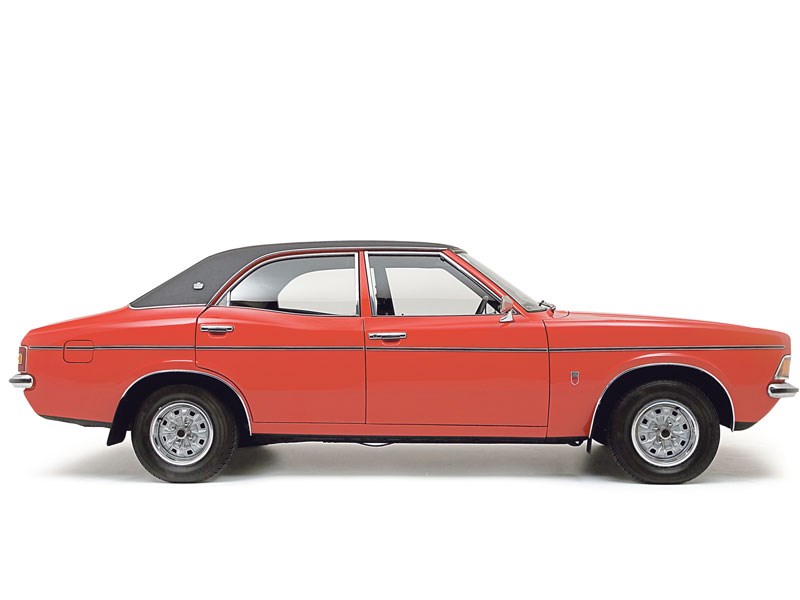Ford’s 1970s fleet favourite makes an excellent family classic...
Early cars greeted the driver with a fabulous angled dashboard, coupled with sunken gauges and fake wood on the top models. Later cars had a squarer dash inspired by the Granada, which would also feature in the Cortina MkIV. A MkIII will never set the world on fire in terms of how it drives, yet the almost American trait of leaning into corners can be fun if you know where the limits are. The Transatlantic feel is further perpuated by the soft suspension, which can start to feel disconcertingly floaty over rough surfaces, especially if past its best. 1.3-litre cars feel sluggish on the road – with a 0-60 time of about 20 seconds – but the overhead-cam-engined models feel more urgent and the two-litre Pinto can sprint to 60mph in about 11 seconds if required. Brakes are well-specced for the models.
When you’ve finished stamping on all the pedals, the MkIII is a sensible family classic that will also give a lot of fun. Just make sure you have Bowie on the eight-track. It will make you love it even more.
VITAL STATISTICS
FORD CORTINA MKIII 2000GXL
Engine 1993cc/4-cyl/OHC
Power (bhp@rpm) 98bhp@5200rpm
Torque (lb ft@rpm) 111lb ft@3500rpm
Top speed 100mph
0-60mph 11sec
Consumption 25mpg
WHAT TO LOOK FOR
BODYWORK & CHASSIS
This is a mass market car of the 1970s so, predictably, rust is likely to be a major issue. Check front and rear valances, sills, door bottoms and jacking points first – these are the main enemies of Cortina longevity. Front wings go around their leading corners and towards the trailing edges. So, check this, the lower part of the screen pillars and the bulkhead underneath. Also investigate the lower rear corners, as rust from here will easily spread to the adjacent sill area. Door pillar bases, the fuel filler neck and boot floor are other common rot traps, as are the rear wheelarches, where double-skinning means water can pool. Also around this area, the bottoms of the rear wings can totally disintegrate due to road grot. Because many Cortinas will have led hard lives, it makes sense to check everywhere. If there’s metal, there’s potential for nasties.
The estate shell, roof, and rear panels are shared with the MkIV and MkV estates, so any of these panels advertised for the later cars will fit. The post-1975 dashboard is also common to the fourth and fifth generation models.
ENGINE
Kent engines (1.3) are known for noisy tappets. They can also fume from under the filler cap due to piston/ring wear and if you hear an intermittent clacking from the engine, it means the cam followers are wearing out, which will eventually wreck the camshaft itself. This is an engine-out job to put right.
Pinto-engined cars (1.6 and 2.0) will be easiest to source but will need most attention upon inspection. Oil must be changed every 5000 miles; failure to do so can lead to a clogged oil spray bar, oil starvation, and eventually rapid camshaft wear.
Pinto timing belts must be renewed at 30,000 miles. The best all-round bet is probably the 2.0, combining modern performance with relatively reasonable economy and an enviable parts supply. On all engines, look for signs of blue exhaust smoke under acceleration, denoting a worn-out engine that will either need rebuilding or replacing.
ELECTRICS
Many of these cars will have been modified by previous owners, to varying levels of competence. If that’s the case, make sure everything has been done properly. Take a close look at the electrics in particular.
RUNNING GEAR
Four-speed boxes are generally reliable, although as high mileages are racked up, synchromesh will start to disappear. Jumping out of top gear under acceleration can also happen. Many have fitted five-speed boxes from Sierras for relaxed cruising.
INTERIOR
There are too many trim variations and model year changes to go into in depth with this guide, but make sure everything is there and in good order as much model-specific trim is unavailable and will be hard to replicate.
OUR VERDICT
You either want to feel eight years old again or you want to be Gene Hunt. The Ford Cortina MkIII will do both, and turn heads at the same time. This is one of those cars that just seems to perfectly encapsulate the year in which it was born, with flamboyant colour schemes, interiors that often flout the boundaries of taste and a pervading sense that the quality is not all it could be. This fashion victim status does make Cortina MkIIIs extremely funky now, especially for a generation discovering old re-runs of The Sweeney via Life on Mars. Away from the glitterball persona, a nice third generation Cortina will draw the crowds far more effectively than any Porsche, for people actually remember them when they were common. Every fill-up, meal stop, and shopping trip becomes a chance to meet new people, who will regale you with tales of whenlong-lost friends used to own one. A once-common classic like a Cortina is an easy way to make new friends – but beware if you’re introvert.
The Ford Cortina MkIII is arguably the original rep-mobile. The ‘Coke bottle’ side profile replaced the more angular lines of previous Cortinas, and the range expanded to replace the outgoing Corsair at the same time. During a seven-year production life, myriad models were available, from two-door saloons through estates to Crayford-modified convertibles. There was – and still is – a Cortina MkIII for everybody, although it is believed only a thousand or so now survive – a quite shocking figutre for a car that sold well over a million. Thanks to Ford standardisation, mechanical parts are still plentiful, although you’ll probably struggle a lot more finding replacement panels. The cars are cheap to run, simple to look after too and can easily be worked on at home. Just as family Fords should be.


